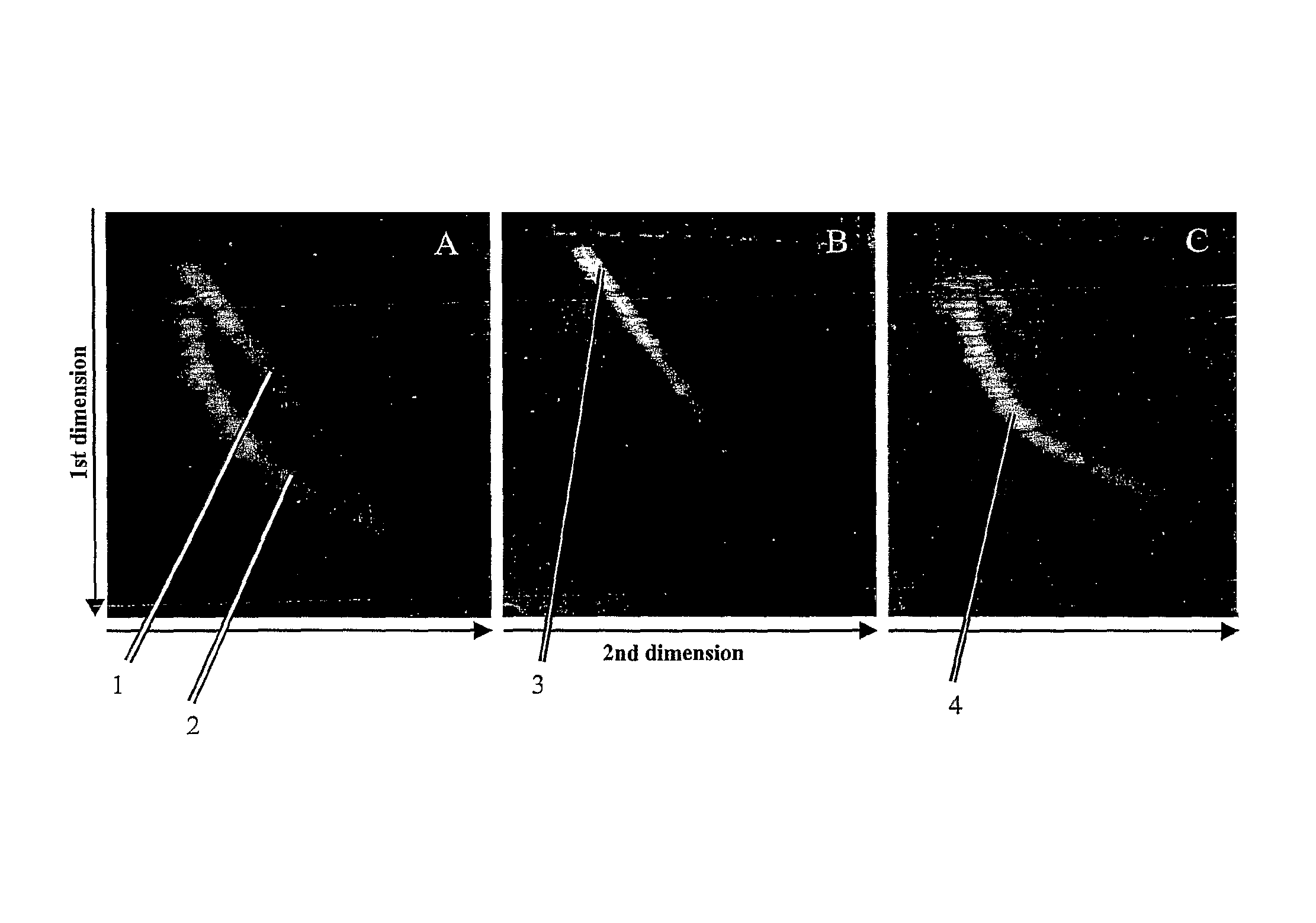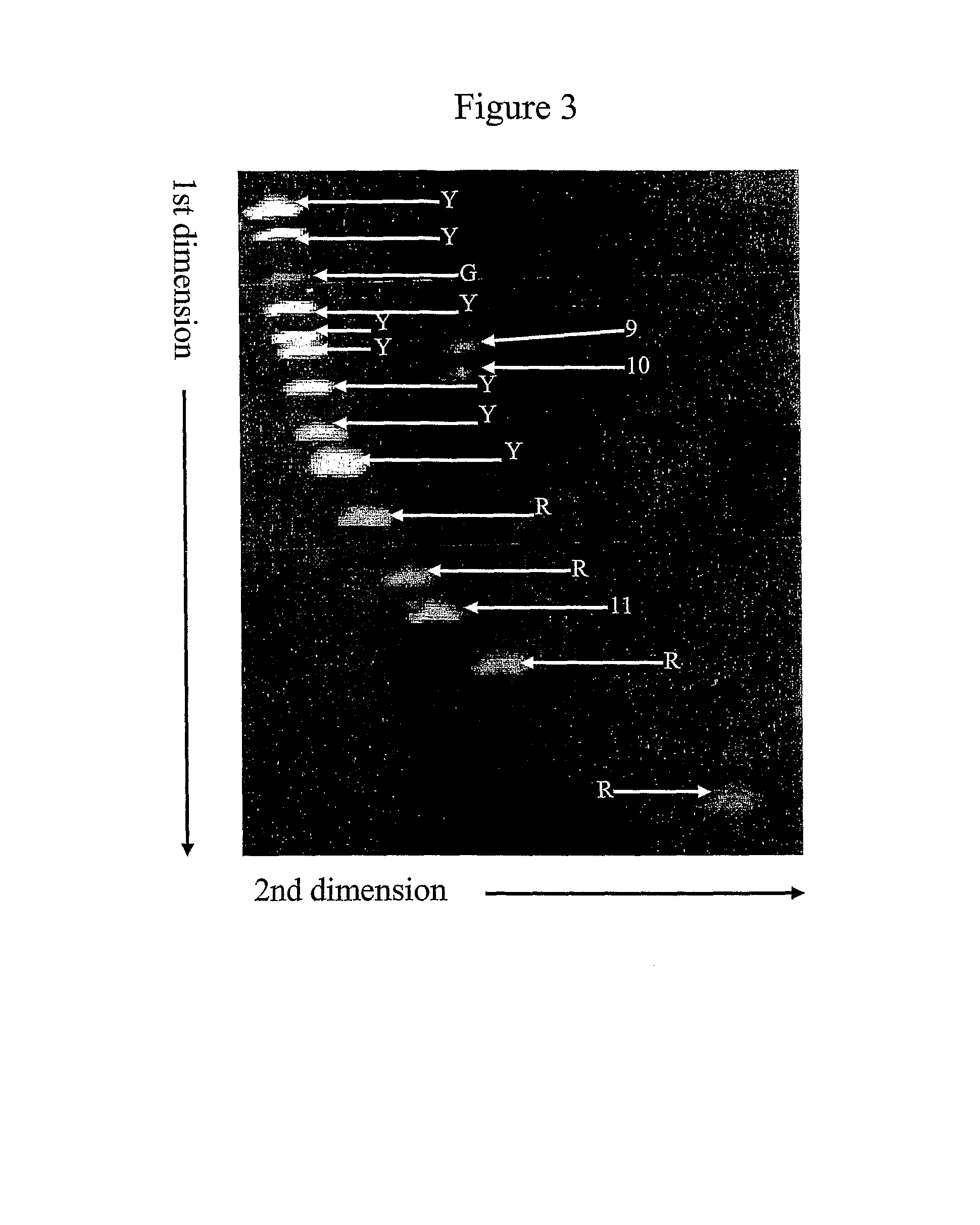Two-dimensional strandness-and length-dependent separation of nucleic acid fragments
a nucleic acid fragment and strandness-dependent separation technology, applied in the field of two-dimensional separation can solve the problems of non-specific nuclease degradation, inability to analyze the association between strandness and length of nucleic acid fragments in complex preparations, and inability to physically separate and isolate either fraction,
- Summary
- Abstract
- Description
- Claims
- Application Information
AI Technical Summary
Benefits of technology
Problems solved by technology
Method used
Image
Examples
example 1
2D-SDE for Length-independent Separation of a Complex Sample Containing Cy3-labeled Single-stranded DNA Fragments and Cy5-labeled Double-stranded DNA Fragments Derived from λ Phage DNA
[0103]λ Phage DNA was digested with the restriction enzyme NdeII resulting in formation of 116 different fragments ranging in size between 12 to 2225 bp. After the digestion the sample was divided into two aliquots. One aliquot was labelled by extension of overhangs using Klenow fragment and Cy5-dCTP. The other aliquot was labelled in the same way with Cy3-dCTP. After labelling reactions the products were purified using GFX PCR and Gel band purification kit.
[0104]Fraction of both Cy3- and Cy5-labelled DNA samples were denatured at 95° C. for 5 min followed by quick transfer to ice-water slush to form single-stranded DNA fragments. Three pools of samples were prepared containing equal amount of Cy3- and Cy5-labelled DNA. The first pool contained denatured Cy3-labelled DNA and untreated Cy5-labeled DNA. ...
example 2
2D-SDE for Strandness and Length-dependent Separation of a Complex Sample Containing Cy3-labeled Single-stranded DNA Fragments and CY5-labeled Double-stranded DNA Fragments Derived from Human Genomic DNA
[0110]To further examine the capacity of 2D-SDE, corresponding experiments as described in Example 1 were performed, now using Cy5- and Cy3-labeled NdeII digested human DNA. Genomic DNA was isolated from whole blood (Puregene DNA isolation kit, Gentra Systems).
[0111]Similar results were obtained as for the λ phage DNA in Example 1. As shown in FIG. 2A, all single-stranded DNA fragments form a line lying diagonal through the gel (red). Double-stranded DNA fragments form an arc lying left to the line of single-stranded fragments (green). No separation of DNA bands was obtained due to the great number and length heterogeneity of digested human DNA. Separation of pools containing denatured Cy5- and Cy3-DNA fragments FIG. 2B) and untreated Cy5- and Cy3-DNA fragments (FIG. 2C) resulted in ...
example 3
2D-SDE to Reveal the Presence of Bulge-containing DNA Fragments in a Complex DNA Sample
[0112]A 274 bp DNA fragment was amplified from exon 11 in the C-kit gene from an individual known to be heterozygote for a 9 bp deletion mutation in that exon. Such amplification resulted in four different DNA hybrids. Two homohybrids (265 bp and 274 bp) and two 265 bp heterohybrids each were containing 9 base bulge in either the sense or anti-sense strand. The PCR products were purified using GFX PCR and Gel band purification kit.
[0113]GeneRuler™ 100 bp DNA Ladder Plus (14 fragments ranging from 100 to 3000 bp) was labelled with T4 DNA polymerase (Fermentas). The ladder was first treated with T4 DNA polymerase without dNTP's. Under these conditions the enzyme has strong 3′ to 5′ exonuclease activity. Mixture of Cy5-dCTP and unlabeled dATP, dTTP and dGTP was then added to the reaction allowing the enzyme to have strong polymerase activity. The ladder was then purified using GFX PCR and Gel band pu...
PUM
| Property | Measurement | Unit |
|---|---|---|
| operating temperatures | aaaaa | aaaaa |
| operating temperatures | aaaaa | aaaaa |
| angles | aaaaa | aaaaa |
Abstract
Description
Claims
Application Information
 Login to View More
Login to View More - R&D
- Intellectual Property
- Life Sciences
- Materials
- Tech Scout
- Unparalleled Data Quality
- Higher Quality Content
- 60% Fewer Hallucinations
Browse by: Latest US Patents, China's latest patents, Technical Efficacy Thesaurus, Application Domain, Technology Topic, Popular Technical Reports.
© 2025 PatSnap. All rights reserved.Legal|Privacy policy|Modern Slavery Act Transparency Statement|Sitemap|About US| Contact US: help@patsnap.com



